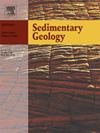重建晚中新世地中海盐巨人(意大利Belice盆地)深岸盆地的古环境:来自与碎屑蒸发岩互层的半深海沉积物的启示
IF 2.9
2区 地球科学
Q1 GEOLOGY
引用次数: 0
摘要
大而深的海相蒸发盆地(盐巨人)在地质记录中是常见的,但古环境的重建是具有挑战性的。沉积产物由碎屑蒸发岩(块体搬运沉积和浊积沉积)组成,通常与蒸发堆积或非蒸发细粒沉积互层,代表背景半深海沉积。对半深海成分的研究可以为这些盆地提供重要的古环境信息。本研究考察了意大利Belice盆地(晚中新世地中海盐巨人的一个深岸盆地)中与石膏浊积岩互层的非蒸发半深海沉积物。研究的序列属于下石膏再沉积单元,形成于墨西inian盐度危机第二期(5.60-5.55 Ma),由层状硅藻质和富有机质页岩、白云质和文石质泥岩组成。沉积学、岩相学和地球化学分析表明,半玄武岩沉积在一个较深的盆地中,在浅水具有较高的初级生产力。水柱和海底的古环境条件受淡水和海水流入平衡的支配。硅藻质页岩记录了大陆径流减少和海洋进入增强的间隔,这引起了水柱混合和海底氧化。其他岩性记录了由河流径流和盆地限制引起的水柱长期分层。海底缺氧和陆相和海相有机质的输入有利于细菌硫酸盐还原后白云石和黄铁矿的形成。这项研究提供了对墨西尼亚盐危机时期深盆地的化学、物理和生物条件的见解。本文章由计算机程序翻译,如有差异,请以英文原文为准。
Reconstructing the palaeoenvironment of a deep onshore basin of the Late Miocene Mediterranean salt giant (Belice basin, Italy): Insights from hemipelagic deposits interbedded with clastic evaporites
Large and deep marine evaporitic basins (salt giants) are common in the geological record, but the reconstruction of the palaeoenvironment is challenging. The sedimentary products consist of clastic evaporites (mass transport and turbiditic deposits), commonly interbedded with evaporitic cumulates or non-evaporitic fine-grained deposits representing the background hemipelagic sedimentation. The study of the hemipelagic component can provide crucial palaeoenvironmental information on these basins. This study examines the non-evaporitic, hemipelagic sediments interbedded with gypsum turbidites from the Belice Basin (Italy), a deep onshore basin of the Late Miocene Mediterranean salt giant. The studied succession belongs to the Resedimented Lower Gypsum unit, formed during the second phase of the Messinian Salinity Crisis (5.60–5.55 Ma) and consists of laminated diatomaceous and organic-rich shales, dolomitic and aragonitic mudstones. Sedimentological, petrographic, and geochemical analyses indicate that the hemipelagites accumulated in a rather deep basin, with high primary productivity in superficial waters. The palaeoenvironmental conditions in the water column and at the seafloor were governed by the balance between the inflows of freshwater and marine water. Intervals of reduced continental runoff and enhanced marine ingression, which induced water column mixing and seafloor oxygenation, are recorded by the diatomaceous shales. The other lithologies record prolonged stratification of the water column, induced by riverine runoff and basin restriction. Seafloor anoxia and the input of terrestrial and marine organic matter favoured the formation of dolomite and pyrite following bacterial sulphate reduction. This study provides insights into the chemical, physical, and biological conditions in a deep basin during the Messinian Salinity Crisis.
求助全文
通过发布文献求助,成功后即可免费获取论文全文。
去求助
来源期刊

Sedimentary Geology
地学-地质学
CiteScore
5.10
自引率
7.10%
发文量
133
审稿时长
32 days
期刊介绍:
Sedimentary Geology is a journal that rapidly publishes high quality, original research and review papers that cover all aspects of sediments and sedimentary rocks at all spatial and temporal scales. Submitted papers must make a significant contribution to the field of study and must place the research in a broad context, so that it is of interest to the diverse, international readership of the journal. Papers that are largely descriptive in nature, of limited scope or local geographical significance, or based on limited data will not be considered for publication.
 求助内容:
求助内容: 应助结果提醒方式:
应助结果提醒方式:


